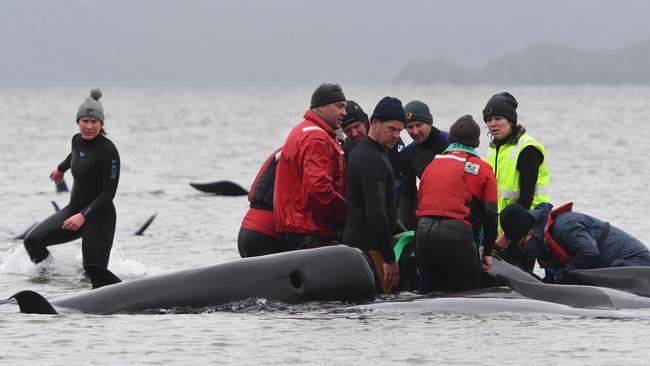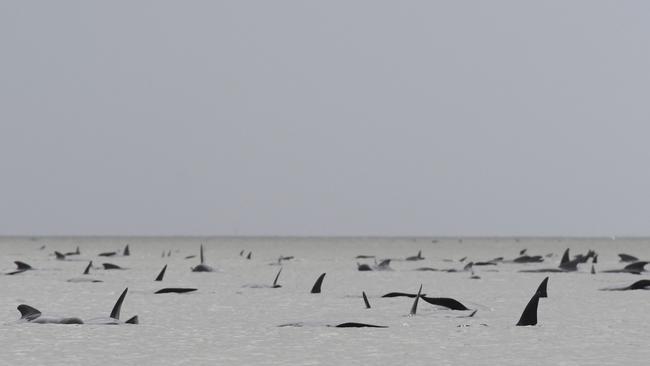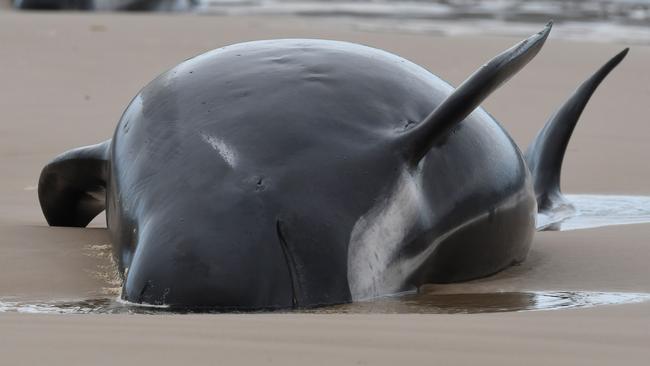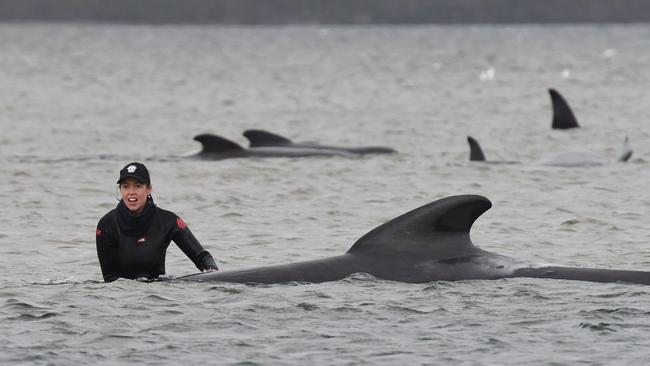Another 200 pilot whales found stranded off Tasmanian west coast
Desperate rescue efforts to save hundreds of pilot whales stranded off Tasmania’s west coast have been dealt another blow.
The race to save more than 200 whales stranded on sandbars off Tasmania’s west coast has been dealt another blow with another 200 found stuck at a different site.
This takes the total number of stranded whales to about 470, marking the biggest whale rescue operation in the state’s history.
According to The Mercury, themajority of the whales discovered at Liberty Bay, south of the original rescue site, have died, meaning it is unlikely they will warrant a rescue effort.
“The other 200 are in a couple of bays. From the air most appear to be dead. Boats will now head out to do an assessment,” Parks and Wildlife regional manager Nic Deka told the publication.

“If they can be saved we will probably send crews over there, but right now the focus is on those alive at Macquarie Heads. There are still a significant number alive.”
Rescue teams managed to free 25 of the 270 whales stranded on sandbars off Strahan, but a small number attempted to return to their pods and rebeached themselves.
Another five were taken out to deep water on Wednesday morning – day three of the major rescue operation.
But despite their best efforts more than a third of the pilot whales are likely to have died before rescuers could get to them.
Hundreds of whales remain stranded on a sandbar off the Macquarie Heads boat ramp, while another 30 are stuck further north at Ocean Beach.
It’s hoped the operation will gather some steam and more whales will continue to be freed on Wednesday as rescuers become more efficient.

Earlier, Mr Deka explained the rescued whales had been escorted out of Macquarie Harbour using a boat and a sling.
He said they were then released near Pilot Bay, which was outside the heads in the Southern Ocean.
“The whales we have been rescuing have been closest to the deeper water of the channel, and that’s where most of the efforts has been focused,” Mr Deka said.
“We think about a third of the whales have perished. However, we will be trying to do a more detailed assessment (on Wednesday) using infra-red camera imagery from the air.”

Authorities remain confident the remaining whales can survive for a few days, with cooler and wetter weather providing relief for the ocean giant but hampering rescue efforts.
“Inevitably, the longer the event goes on the higher the likelihood that the animals will perish if they can’t be released,” Mr Deka said.
Marine Conservation Program wildlife biologist Dr Kris Carlyon said one of the rescued whales had stranded itself again, but they hoped getting the whales offshore would give them the best chance of survival.
“This is such a tricky, complex event that any whale we save we are considering a real win,” he said.

“We’re focusing on having as many survivors as we can.
“It’s inevitable that we’ve lost more, we haven’t got a tally at this stage, we have been focused on the rescue of live animals.”
The rescue operation could run for a number of days with dozens of staff from the Department of Primary Industry, Water, Parks and Environment joining the search as well as employees from nearby salmon farms.
Five surf clubs from across northern Tasmania have also joined in the rescue effort, The Mercury reports.



To join the conversation, please log in. Don't have an account? Register
Join the conversation, you are commenting as Logout